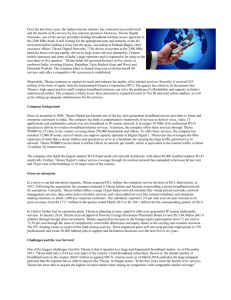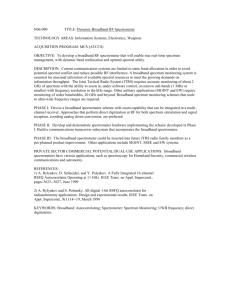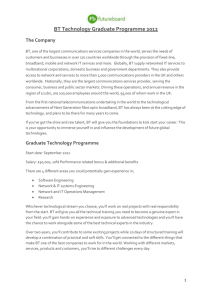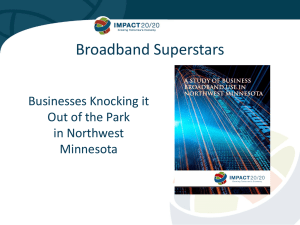Click Here To
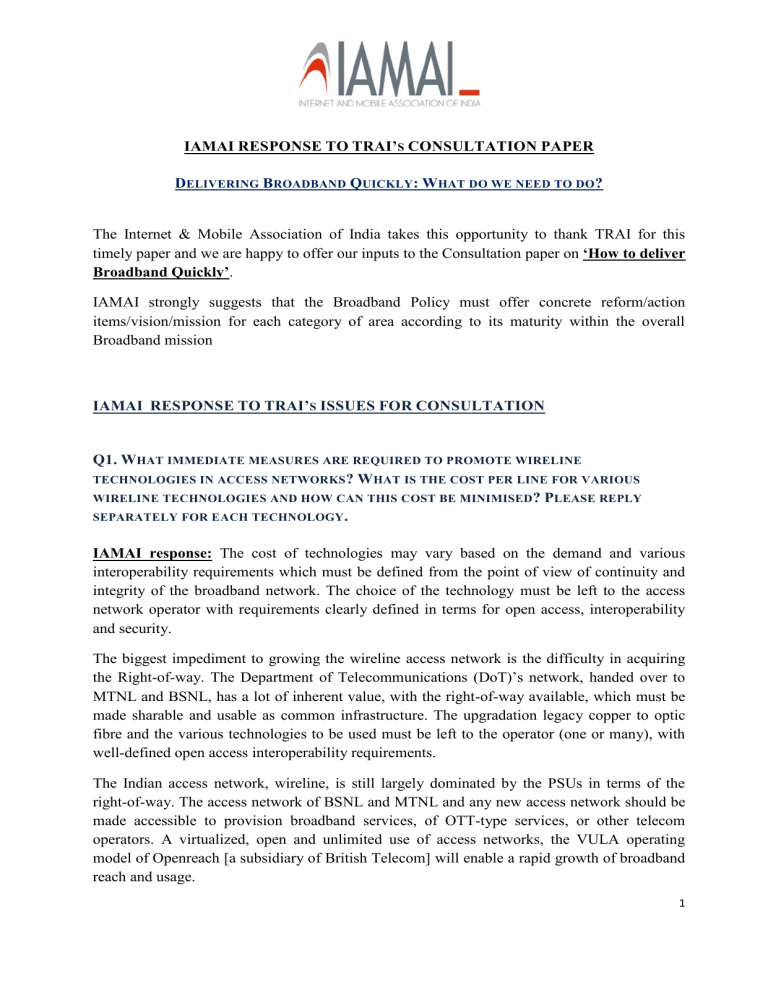
IAMAI RESPONSE TO
TRAI’
S CONSULTATION PAPER
D
ELIVERING
B
ROADBAND
Q
UICKLY
: W
HAT DO WE NEED TO DO
?
The Internet & Mobile Association of India takes this opportunity to thank TRAI for this timely paper and we are happy to offer our inputs to the Consultation paper on ‘How to deliver
Broadband Quickly’
.
IAMAI strongly suggests that the Broadband Policy must offer concrete reform/action items/vision/mission for each category of area according to its maturity within the overall
Broadband mission
IAMAI RESPONSE TO
TRAI’
S ISSUES FOR CONSULTATION
Q1.
W
HAT IMMEDIATE MEASURES ARE REQUIRED TO PROMOTE WIRELINE
TECHNOLOGIES IN ACCESS NETWORKS
?
W
HAT IS THE COST PER LINE FOR VARIOUS
WIRELINE TECHNOLOGIES AND HOW CAN THIS COST BE MINIMISED ?
P LEASE REPLY
SEPARATELY FOR EACH TECHNOLOGY
.
IAMAI response: The cost of technologies may vary based on the demand and various interoperability requirements which must be defined from the point of view of continuity and integrity of the broadband network. The choice of the technology must be left to the access network operator with requirements clearly defined in terms for open access, interoperability and security.
The biggest impediment to growing the wireline access network is the difficulty in acquiring the Right-of-way. The Department of Telecommunications (DoT)’s network, handed over to
MTNL and BSNL, has a lot of inherent value, with the right-of-way available, which must be made sharable and usable as common infrastructure. The upgradation legacy copper to optic fibre and the various technologies to be used must be left to the operator (one or many), with well-defined open access interoperability requirements.
The Indian access network, wireline, is still largely dominated by the PSUs in terms of the right-of-way. The access network of BSNL and MTNL and any new access network should be made accessible to provision broadband services, of OTT-type services, or other telecom operators. A virtualized, open and unlimited use of access networks, the VULA operating model of Openreach [a subsidiary of British Telecom] will enable a rapid growth of broadband reach and usage.
1
Q2.
W
HAT ARE THE IMPEDIMENTS TO THE DEPLOYMENT OF WIRELESS TECHNOLOGIES IN
THE ACCESS NETWORK
?
H
OW CAN THESE DEPLOYMENTS BE MADE FASTER
?
P
LEASE
REPLY SEPARATELY FOR EACH TECHNOLOGY
.
IAMAI response:
The white spaces (allocated but locally unused frequencies) being freed up by India’s switchover to digital television, which is ideal for coverage in rural areas and is underutilized in India relative to other parts of the world. The spectrum used for TV broadcasts as well as the
“white spaces” between individual TV channels have been proven over the past 2 years to be an effective source of capacity for providing mobile broadband. This is particularly true for people living in rural geographies given the excellent propagation characteristics of these frequencies
Q3.
T
HE RECOMMENDATIONS OF THE
A
UTHORITY ON
M
ICROWAVE BACKHAUL HAVE
BEEN RECENTLY RELEASED
.
A
RE THERE ANY OTHER ISSUES WHICH NEED TO BE
ADDRESSED TO ENSURE AVAILABILITY OF SUFFICIENT M ICROWAVE BACKHAUL CAPACITY
FOR THE GROWTH OF BROADBAND IN THE COUNTRY ?
IAMAI response: In light of the fact that 802.11ad will be utilized as the next high bandwidth
WIFI band that is migrating from indoor use to outdoor use, the V-band (57-64 GHz band) should not be licensed. The light licensing of the E-band in certain countries has resulted in its being underutilized, so this should be avoided for the V-band.
Q4.
T
HE PRICING OF
D
OMESTIC
L
EASED
C
IRCUITS
(DLC)
HAVE BEEN REVIEWED IN
J
ULY
2014.
A
PART FROM PRICING
,
ARE THERE ANY OTHER ISSUES WHICH CAN IMPROVE
AVAILABILITY OF
DLC?
IAMAI response: There should be a review of utilizing BSNL/MTNL exchange infrastructure as a common infrastructure, which can greatly facilitate reduction of pricing of domestic leased circuits
Q5.
W
HAT ARE THE SPECIFIC REASONS THAT
ISP
S ARE PROACTIVELY NOT CONNECTING
WITH
NIXI?
W
HAT MEASURES ARE REQUIRED SO THAT ALL
ISP
S ARE CONNECTED TO
THE NIXI?
IAMAI response: The ISPs tend to buy transit directly at the POPs of the telecom operators who have data centres and content hosted in India and/or connectivity to other Internet exchanges in the world since the ISP is not guaranteed complete visibility of internet sites in
India or overseas through a Nixi exchange. The POPs (points of presence) of the telecom providers are better located on the network and ensure more reliable operations in terms of continuity and updates of routes.
We suggest as possible options:
2
Locate Nixi exchanges at the BSNL/MTNL exchanges, well located throughout the country with a ready access network which can be improved.
Locate Nixi exchanges at major data centres, which may bid for hosting the Nixi exchanges. All data centres must be mandated to advertise networks and network prefixes sold by them to content & service providers, at all Nixi locations, either by themselves, or through a telecom operator.
Q6.
W OULD THE HOSTING OF CONTENT WITHIN THE COUNTRY HELP IN REDUCTION OF
THE COST OF BROADBAND TO A SUBSCRIBER ?
I F YES , WHAT MEASURES ARE REQUIRED TO
ENCOURAGE CONTENT SERVICE PROVIDERS TO HOST CONTENT IN THE DATA CENTRE
SITUATED WITHIN
I
NDIA
?
IAMAI response : this needs to be discussed and debated as a separate CP. Data localisation is a long term matter and the current paper discusses means of delivering broadband speedily in the short term.
There is a need to make environment favorable for Data Flow and create an atmosphere promoting Ease of doing business, policy reforms, and taxation. IAMAI is working on a detailed paper on this matter, and we would be happy to share the same with the regulator.
Q7.
A RE PSU S IDEAL CHOICES FOR IMPLEMENTING THE N ATIONAL O PTICAL F IBRE
N ETWORK (NOFN) PROJECT ?
IAMAI response: Firstly, the National Optical Fiber Network [NOFN] must include the urban optic-fiber network segments. The National Optic Fiber Network must be re-defined as an interconnection of various access network segments –both wire line and wireless.
Since NOFN will be a vital national asset, it must be built, operated and regulated by an autonomous undertaking, at arm’s length from the telecom companies, private or public.
Q8.
S
HOULD AWARDING OF
EPC
TURNKEY CONTRACTS TO PRIVATE SECTOR PARTIES
THROUGH
I
NTERNATIONAL
C
OMPETITIVE
B
IDDING
(ICB)
BE CONSIDERED FOR THE
NOFN PROJECT ?
IAMAI response : Competitive global bidding may be considered here.
Q9.
A
RE THERE ANY WAYS IN WHICH INFRASTRUCTURE DEVELOPMENT COSTS CAN BE
REDUCED
?
I
S IT POSSIBLE TO PIGGYBACK ON THE EXISTING PRIVATE SECTOR ACCESS
NETWORKS SO AS TO MINIMIZE COSTS IN REACHING REMOTE RURAL LOCATIONS
?
3
IAMAI response: The last mile connectivity should be provided by the cable operators, tier II
& III ISPs and telcos present in the areas. A robust private sector involvement to close the loop will go a long way in achieving targets. The private sector last mile connectors may be incentivized to connect the last mile.
Q10.
W HAT CAN THE PRIVATE SECTOR DO TO REDUCE DELIVERY COSTS ?
P LEASE
PROVIDE SPECIFIC EXAMPLES
.
IAMAI response: Deployment of infrastructure has been signaled as the most important input cost determining the price-point for Broadband access. For Passive infrastructure such as conduits and towers, policies should adopt a “dig once, build once” philosophy that allows providers installing such infrastructure to determine if others wish to utilize that infrastructure and share in the initial costs of deploying it.
State-owned BSNL and MTNL have a robust last mile infrastructure which is critical to reach the services to the end customers waiting for service with acceptable QoS (quality of service).
Such infrastructure could be re-used and augmented where necessary and made available unbundled to all service providers, both public and private.
Q11.
W
HAT ARE THE MAJOR ISSUES IN OBTAINING RIGHT OF WAY FOR LAYING OPTICAL
FIBRE
?
W
HAT ARE THE APPLICABLE CHARGES
/
CONSTRAINTS IMPOSED BY VARIOUS
BODIES WHO GRANT PERMISSION OF RIGHT OF WAY
?
I
N YOUR OPINION WHAT IS THE
FEASIBLE SOLUTION ?
IAMAI response : IAMAI is not qualified to answer this question.
Q12.
S
HOULD THE
G
OVERNMENT CONSIDER FRAMING GUIDELINES TO MANDATE
COMPULSORY DEPLOYMENT OF DUCT SPACE FOR FIBRE / TELECOMMUNICATIONS CABLES
AND SPACE FOR TELECOMMUNICATION TOWERS IN ALL MAJOR PHYSICAL
INFRASTRUCTURE CONSTRUCTION PROJECTS SUCH AS BUILDING OR UPGRADING
HIGHWAYS
,
INNER
-
CITY METROS
,
RAILWAYS OR SEWER NETWORKS
?
IAMAI response: Yes, the Govt. should consider mandatory duct space for fiber on all large public and private infrastructure deployments that can be shared among all providers of service. There is a need to mandate that fiber infrastructure dig permits be accompanied by a permission to install conduit and permit fiber-pulls by any other party for an ‘at-cost’ basis. Similarly, all towers erected with permission of the government for the purposes of providing data access could be made available to third parties on a ‘cost only’ basis provided such use does not interfere with the primary tenant's activities.
Q13.
W HAT ARE THE IMPEDIMENTS TO THE PROVISION OF B ROADBAND BY C ABLE
OPERATORS
?
P
LEASE SUGGEST MEASURES
(
INCLUDING POLICY CHANGES
)
TO BE TAKEN
4
FOR PROMOTING BROADBAND THROUGH THE CABLE NETWORK
.
IAMAI response : Incentivize the cable operators to upgrade networks in order for them to provide last mile connectivity in all areas. The obligation to connect last mile should not come with the demand for any new license.
Q14.
W
HAT MEASURES ARE REQUIRED TO REDUCE THE COST AND CREATE A PROPER ECO
SYSTEM FOR DEPLOYMENT OF
FTTH
IN THE ACCESS NETWORK
?
IAMAI response: The Govt should implement tax credits for deployment of FTTH to promote infrastructure innovation.
Q15.
A
RE THERE ANY REGULATORY ISSUES IN PROVIDING INTERNET FACILITY THROUGH
W
I
-F
I
H
OTSPOTS
?
W
HAT ARE THE REASONS THAT INSTALLATION OF
W
I
-F
I HOTSPOTS
HAS NOT PICKED UP IN THE COUNTRY ?
W HAT TYPE OF BUSINESS MODEL NEEDS TO BE
ADOPTED TO CREATE MORE W I -F I HOTSPOTS ?
IAMAI response: There are no regulatory issues involved in providing Wi Fi hotspots..
Currently used models for offering free Wi-Fi at airports may be considered as a business model for this.
Q16.
W
HAT ARE OTHER SPECTRUM BANDS WHICH CAN BE UNLICENSED FOR USAGE OF
W I -F I TECHNOLOGY OR ANY OTHER TECHNOLOGY FOR PROVISION OF BROADBAND ?
IAMAI response: To connect rural and remote areas it is important to provide a balance of both licensed and unlicensed spectrum, the availability of unlicensed spectrum may be critical to those high cost areas to help bring down costs and allow for any community to deploy their own wireless infrastructure. Spectrum policy should include
Govt. may consider to open up as much 5.8 GHz unlicensed spectrum as possible in support of additional WIFI capacity needs.
There are consistent rules and principles already established for managing this spectrum, including from the FCC, Ofcom, and also such groups as the Dynamic Spectrum Alliance. This
TVWS spectrum is a rich resource available to India and its people, and one that India could benefit from more than many other countries given India’s more rural population, that is untapped to date.
Q17.
H OW MUCH SPECTRUM WILL BE REQUIRED IN THE IMMEDIATE FUTURE AND IN THE
LONG TERM TO MEET THE TARGET OF BROADBAND PENETRATION ?
W HAT INITIATIVES
ARE REQUIRED TO MAKE AVAILABLE THE REQUIRED SPECTRUM ?
5
IAMAI response:
IAMAI is not qualified to make a quantitative assessment. However, the following points may be noted:
The focus must be to allocate sufficient spectrum to meet fast-growing demand for mobile
Broadband. It is important (especially for non-urban areas) that Government views spectrum as a Broadband enabling resource and not merely revenue generation.
The government should periodically re-evaluate spectrum allocation to identify underused or unused spectrum and reallocate it for/allow efficient use in each market. Policies regarding spectrum sharing, trading, re-farming and proposals such as mobile virtual network operator
(MVNO) should be finalized. This may allow smaller players, without the wherewithal of the
TSPs for spectrum auctions to provide broadband for select markets where they enjoy relative strengths.
In places where mobile operators hold spectrum licenses but have not built out their networks,
“use or lose” rules should be put in place, whereby, if operators have not built out certain geographies by a certain time, then that spectrum must be made available to entities who are willing to build out certain areas. A single operator is often challenged to capture enough voice and data traffic to cover their opex in these geographies, the Govt should consider legalizing
MVNO’s as a way to further leverage the existing spectrum that has already been allocated and assigned for mobile services.
Q18.
A
RE THERE ANY OTHER SPECTRUM BANDS APART FROM THE ONES MENTIONED IN
C
HAPTER
-2
TO BE IDENTIFIED FOR PROVISION OF WIRELESS BROADBAND SERVICES
?
IAMAI response: The V-band [57-64 Ghz] may be exempted from licensing. This wave has been largely unexploited for commercial wireless applications despite having impressive performance characteristics. Due to its capacity of providing short range but high data rate communication, it can be used as low-cost, high capacity short-range back haul alternative to connect wireless broadband networks.
Q19.
W HAT ARE THE MEASURES REQUIRED TO ENCOURAGE G OVERNMENT AGENCIES TO
SURRENDER SPECTRUM OCCUPIED BY THEM IN
IMT
BANDS
?
IAMAI response: IAMAI is not qualified to answer this question.
Q20.
W HAT SHOULD BE THE TIME FRAME FOR AUCTIONING THE SPECTRUM IN 700 MH Z
BAND ?
IAMAI response: Because of its technical characteristics, the spectrum in the 700 MHz band is especially useful for broadband deployment. Its frequencies can carry data efficiently; it travels further and is more easily able to penetrate walls. In this light, auctioning the spectrum as soon as practicable is advised, especially if the auction is conducted in a manner that requires speedy deployment of infrastructure and emphasizes the availability of affordable services.
6
Q21.
D
O YOU AGREE WITH THE DEMAND SIDE ISSUES DISCUSSED IN
C
HAPTER
5
AND
C
HAPTER
6?
H
OW THESE ISSUES CAN BE ADDRESSED
?
P
LEASE ALSO INDICATE ANY
OTHER DEMAND SIDE ISSUES WHICH ARE NOT COVERED IN THE
CP.
IAMAI response: Lack of local language content and tools (fonts, keyboards and scripts) for end users are a hurdle to Internet adoption. 42% of people accessing the internet prefer accessing Internet only in local languages..
In addition, in order to encourage internet usage, the government should create a market environment that fosters local content innovation, maximizes Internet freedom, and increases openness and transparency. Such policies will lead to more cross-industry partnerships, collaboration, and innovation that will increase efficiencies.
In the digital literacy campaign, educating consumers about how the Internet works may lead to greater appreciation of its capabilities and increased usage. Increasing consumers’ understanding of cloud computing and how the Internet really works may lead to more frequent usage for routine tasks currently done using other offline resources.
Q22.
P
LEASE GIVE YOUR COMMENTS ON ANY RELATED MATTER
,
NOT COVERED ABOVE
.
IAMAI response: The development of innovative, robust, and affordable on-line applications and G2C content by the government will facilitate more efficient delivery of public services such as healthcare, public safety, education, and economic development. By subsidizing community anchor institutions, the government can ensure all citizens have access to the basic services contemplated in the “Right to Broadband”.
The average speed proposed should also be specified. India at present has the lowest average internet speed in 14 countries in APAC. India also accounts for just 2% of the entire set of unique IP addresses around the world, compared to China’s 14 percent.
Consistent with its declaration on establishing 100 new model cities in India, the Government should play a key role in establishing and implementing a clearly articulated plan for broadband enablement for 100 cities in each calendar year. Broadband enabled measures such as e-commerce is expected to result in economic growth for the domestic manufacturing sector which is traditionally concentrated equally (if not more) in medium – small settlements and towns in comparison with major metros or million+ population cities.
7
IAMAI RESPONSE TO TRAI’ S CONSULTATION PAPER
D
ELIVERING
B
ROADBAND
Q
UICKLY
: W
HAT DO WE NEED TO DO
?
Extra comments:
Q13. What are the impediments to the provision of Broadband by Cable operators? Please suggest measures (including policy changes) to be taken for promoting broadband through the cable network.
IAMAI response: Some of the impediments to the provision of Broadband by Cable
Operators are:
•
Complex and long process for obtaining ISP licensing for cable operators
•
Lack of intra-city fiber network for rolling out Digital Access Architecture.
In order to promote Broadband through cable, MSOs (Multi Service Operators), LCOs (Local
Cable Operators) and Service providers should be incentivized to roll out cost effective broadband data services. Such incentives should include
•
Granting “information infrastructure” status to cable networks that roll out broadband data services. In the UK, which has a highly competitive broadband access market, regulator OFCOM recently noted that “the average broadband speed delivered by
•
Providing inter-city intra-city digital fiber connectivity OR bulk bandwidth at reasonable price points to carry the subscriber broadband traffic to their POPs.
•
Easing of licensing norms and providing deemed-ISP-license to cable operators one month after filing for license. cable services is now faster than that of fibre” and that a cable operator, Virgin
Media, was providing the fastest residential broadband access speeds
1
.
•
Easing of duties on cable infrastructure equipment used for providing broadband services for the next 5 years.
